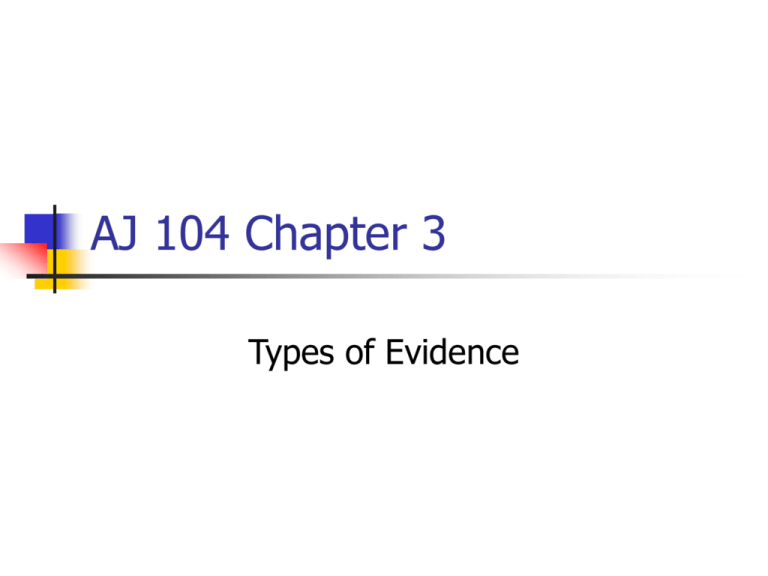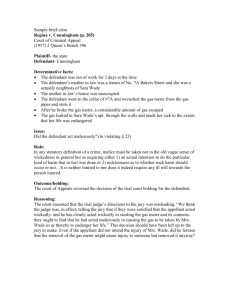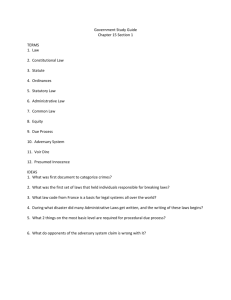AJ 104 Chapter 3
advertisement

AJ 104 Chapter 3 Types of Evidence 1. Relevant Evidence Any evidence that tends to prove or disprove any disputed fact in the case. Relevant evidence needs to show that it is more probable that the fact exists than it appeared before the evidence was introduced. No single piece of evidence has to make a fact appear more probable than not. Examples of Relevant Evidence 1. 2. 3. 4. 5. Defendant’s fingerprints on the murder weapon Defendant was the last person seen with the victim before her death Defendant was the beneficiary of a large insurance policy Defendant had previously threatened to kill the victim Defendant disappeared the day after the victim died Keys to Relevancy Is it “at issue” Can it be used to establish the elements Guilt beyond as reasonable doubt The facts necessary to establish defense are at issue as well Admissibility Only relevant evidence is admitted in court Probative value (evidence must make it appear that a fact probably occurred) Relevant Evidence - Material Two definitions: Evidence is material if it is logically connected with some fact that is “at issue” Material evidence is evidence that is important to the case-it cannot be too remotely connected to the facts of the case Evidence is Relevant if: It must be relevant to some fact that is at issue It must have more than just a remote connection to the fact Evidence is not relevant if It does not have probative value Unduly prejudicial due to its emotional impact on the jury Arouses hostility or sympathy toward either side Prior convictions is usually not admissible (during the case-in-chief) Evidence that may distract the jury Admissible or Not? Photos of a murder victim would be considered relevant A laboratory test that only shows a low probability of having the same disease A witness testifying to impeach someone who has already testified Cumulative Evidence Evidence that restates what has already been admitted into evidence This type of evidence may also be excluded If ten eyewitnesses are called to testify to the same thing, after the first witnesses, the judge is likely to sustain an objection that the evidence is “cumulative” Multiple witnesses may be called to corroborate. Corroborative Evidence Supports prior testimony by providing additional evidence without merely duplicating it. Limited admissibility – evidence may be relevant if introduced for one purpose but irrelevant for some other purpose. Example of Corroboration Jane testified that she was at Beverly & Peck (holler-back girl) Road at midnight on Sept. 9th when she saw a red corvette speed past. As it went by someone threw an apparently empty bank bag out of the window. Paul testified that he walked across the street at Beverly & Peck at 11:55 p.m. on his way to the liquor store and there was nothing unusual on the ground. On his way home 10 minutes later, he found an empty bank bag in the streets. Relevant or Not? Witness to bank robbery wrote down the license number of a car used in a crime. The records show that the defendant owned the car with the same license. Five minutes after a theft, the defendant was stopped near the scene. Defendant had a unique ring in her pocket that had been taken in the theft. Relevant or not? In a rape trial, the defendant has admitted that he had sexual intercourse with the victim. His defense is based his claim that the victim consented to the sexual encounter. The prosecutor wants to admit evidence that the defendant matches the physical description given to the police by the victim immediately after the crime. Direct Evidence Direct Evidence Based on personal knowledge or observation of the person testifying. No inference or presumption is needed. If the testimony is believed by the jury, the fact it relates to is conclusively established. Always Relevant “I saw the defendant shoot the victim….” Circumstantial Evidence Circumstantial evidence indirectly proves a fact. It requires the trier of fact to use an inference or presumption in order to conclude that the fact exists. Based upon “inference” Jury must make a presumption (more on this later) It can be strong enough to convict or weak enough to acquit. Examples The defendant was seen running from the scene immediately after the crime The defendant was the only person who knew the combination to the safe Inference? Inference The victim had a reputation for being a bully Inference Examples Eyewitness saw the defendant put poison in the food. Inference? Eyewitness saw the defendant fire the weapon Inference? Testimonial Evidence Evidence that is given by a competent witness while testifying under oath or affirmation in a court proceeding. The evidence is introduced on the witness stand. “Do you swear or affirm the testimony you are able to give is the truth, whole truth, and nothing but the truth?” Confused? Real Evidence Physical Evidence Demonstrative Evidence Tangible Evidence Documentary Evidence Various authors define one term to include the others. The above terms are frequently used and interchangeable. Real Evidence Anything except testimonial evidence that can be perceived with the five senses that tends to prove a fact that is at issue. Examples of Real Evidence Physical Items: Guns, Knives, Clothing Documents: Checks, Contracts, Letters, Notes, Deeds, Wills, Fingerprint Cards, Computer Files Exhibits: Models, Scales, Drawings, Charts Pictures: Still Photos, Videos, Digital Images, Photocopies, X-Ray films Substitutes for Evidence Situations in which the jury is specifically told what facts to believe rather than having the opposing sides introduce evidence on the issue. 1. 2. 3. Stipulations Judicial Notice Presumptions Don’t Instigate, Stipulate A stipulation is: An agreement between the opposing attorneys to admit that one or more facts exists is called a stipulation. Pre-trial, a written document During trial, stated orally for the record. Why Stipulate? Knowledge – One side knows what the other side can easily prove the facts involved. Prejudice – The facts would prejudice the jury against the defendant Time Consuming – Both sides agree that proving small details would be time consuming, therefore will stipulate. Examples of Stipulations In a drunk driving case, it may be stipulated that the ER staff used proper techniques in taking the blood sample from the defendant. The event occurred at 10:00 p.m. Both sides stipulate that the crime occurred at night. Judicial Notice A procedure where the judge on their authority advises the jury to conclude a fact exists. Once advised by the judge, the jury is required to follow instructions. Also referred as “commonly known facts” Examples of Judicial Notice Codified Laws: US Constitution, State Constitution, state laws Court Records Scientific Facts: Temps, sunrise/sunset, radar equipment Local Facts: Which cities are in the court district, landmarks, streets that run north/south, etc. Presumptions A conclusion which the law requires the jury to draw from facts that have been established at trial. The judge instructs the jurors when they are to se a presumption Based upon a logical assumption Must be established beyond a reasonable doubt Two Types of Presumptions Rebuttable Strong Weak Conclusive Social policy is strongest No one is allowed to refute the existence of a presumed fact There are few conclusive presumptions Conclusive Presumption Basic Fact Presumed Fact Opposing side may attack basic fact but may not attack presumed fact Strong Rebuttable Presumption Basic Fact Fact Presumed Opposing side may attack either the basic fact but or the presumed fact. Weak Rebuttable Presumption Basic Fact Presumed Fact If opposing side introduced evidence to disprove any part of the presumption, the jury will not be told about the presumption. Review Questions 1. 2. 3. 4. Define relevant and material evidence and explain how they differ. List two situations where relevant evidence would not be admissible in court. Define direct and circumstantial evidence and give two examples of each. Define testimonial and real evidence and give two examples of each. Review Questions 5. 6. 7. 8. Compare and contrast stipulation and judicial notice, and give two examples of facts that could be judicially noticed Define inference, and give an example of its application Differentiate between a rebuttable presumption and a conclusive presumption Give an example of a conclusive presumption and a rebuttable presumption Vocabulary Terms At Issue Circumstantial Evidence Documentary Evidence Material Evidence Probative Value Substitutes for Evidence Testimonial Evidence Cumulative Evidence Corroborative Evidence






